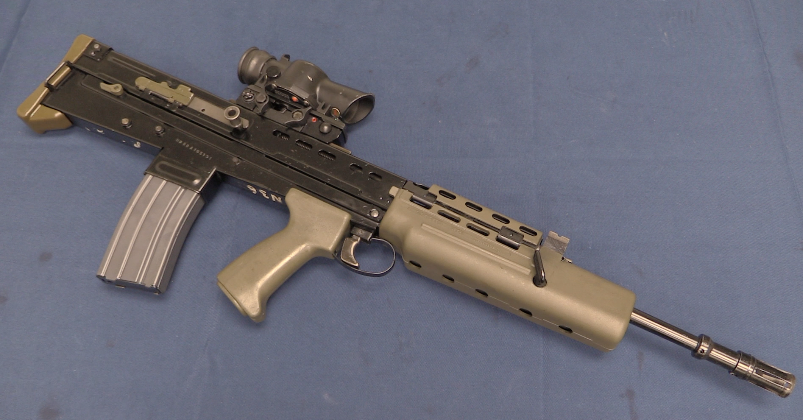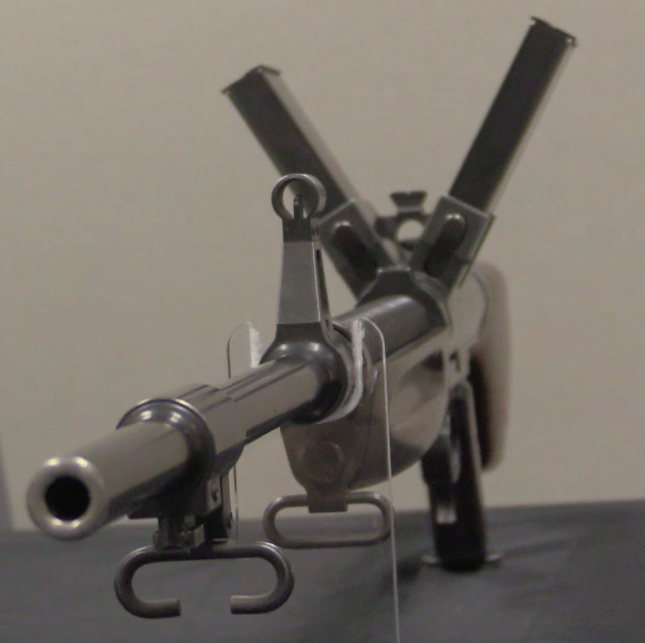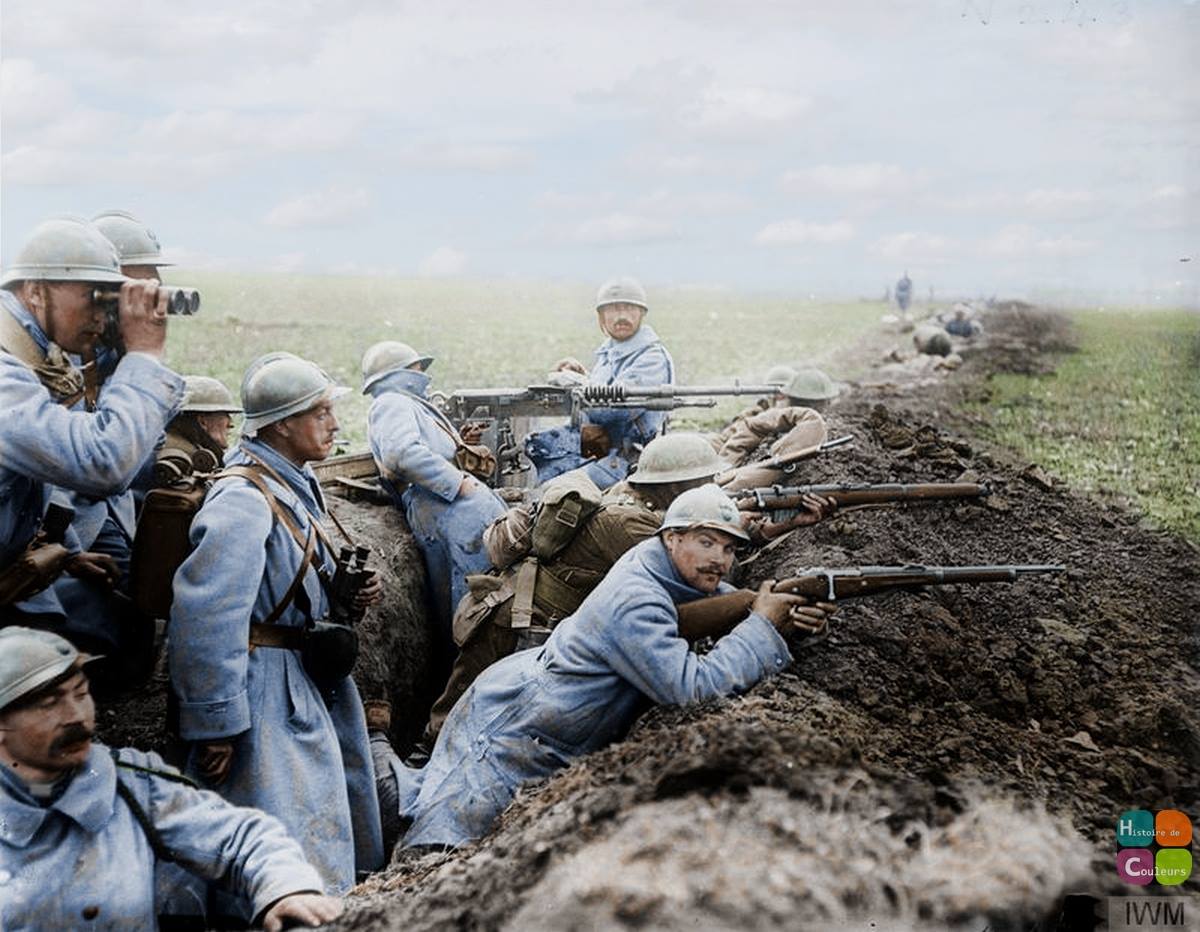A Lewis Gun, in .303 British, at 2000 frames per second:
The Lewis Gun was developed by American Isaac Newton Lewis shortly before WWI, but the US military was not interested in it (in part because of a bitter dislike between Lewis and the Chief of Army Ordnance Crozier). Lewis instead licensed production to BSA in England, and the gun because a major part of UK armament during the First World War, both in ground and aerial roles. For a more complete view of the Lewis, check out my previous video on it, with disassembly and shooting:
Updated to add:
As pointed out by Daniel Watters, General Crozier’s book about his work during WWI (which is largely a defense of his actions regarding the Lewis) is in the public domain, and can be read or downloaded free at Archive.org. A good way to see the other side of the story, for folks who are interested.




Ian: Gen. Crozier’s book is now in the public domain, and several online sources have available for free download. It is worth reading for a counter to Col. Lewis’s claims.
Here’s a Google link to Crozier’s “Ordnance and the World War”.
https://play.google.com/books/reader?printsec=frontcover&output=reader&id=GaVDAAAAIAAJ&pg=GBS.PP1
Reading Crozier’s account shows that there certainly is another side to the story, and reading between the lines my personal impression is that yes, these two guys really hated each other.
Without reading Gen. Crozier’s defense of the U.S. Army’s decision not to show interest in the Lewis gun, does it not seem as though there are repeated instances of the Army Ordinance Department’s hierarchy turning down innovative weapons that ended up proving their worth?
Part of the issue is that every inventor claims that their design is a game-changer whether or not the product actually has merit. Moreover, even when a design eventually showed merit, it may not have been sufficiently debugged when the initial tests occurred years earlier. You also have issues with the end-users presenting conflicting requirements and the ever-present spectre of finding sufficient funds for adequate RDT&E. Every time an inventor crawled out of the woodwork with an unsolicited design proposal, any testing of the latter siphoned budget funds from existing projects of record.
And also having well-working prototype don’t guarantee that production fire-arm (or anything) will be so good. Note from example Tupolev TB-3 bomber, http://en.wikipedia.org/wiki/Tupolev_TB-3 states that:
“Unexpectedly, subsequent mass-produced aircraft were found to be 10–12% heavier than the prototype, which significantly hampered performance.[1] The discrepancy was discovered to be due to high positive tolerances on raw materials which resulted in steel sheetmetal, pipes, and wires being much thicker than on the carefully constructed prototypes.”
Given that the US Marines in France were actually forced to hand in their Lewis guns in return for Chauchats, I think we can assume that there was more to this than any minor technical issues with the Lewis.
As to the video, it is fascinating to see the rounds in the pan actually jiggle as the gun is fired, that is something you would never notice at normal speed.
You’re right. Some of the top brass of the US Army made sure that Lewis’s gun would never be issued to the troops and so Lewis would be forced to get back in line if he wanted to keep his rank and pension. Had not Lewis sold his guns to England, he might have become jobless due to all the politicking (and he was actually infringing upon the McClean gun’s patent, if I’m not mistaken).
Hatcher preferred the Benet-Mercié over the Lewis.
Can you get hold of one of them and do a head-to-head with the Lewis?
“Hatcher preferred the Benet-Mercié over the Lewis”
Also the Hotchkiss Portative was just actually in service in United States, so the resistance against adopting new, tactically similar fire-arm was rational.
I have a friend with a Hotchkiss Portative, which is basically a Benet-Mercie in .303. When we are able, that type of comparison is something we very much want to do (also with a BAR).
“Hotchkiss Portative”, “BAR”
The Madsen MG also fit that category (WW1 portable machine gun), so if possible add it to this comparison. I fear about availability of this pattern of fire-arm, but on the other hand Madsen MG was produced in big quantity and in long period of time.
Interestingly the Lewis was issued to Australian Light Horse regiments in July 1916, but found unsatisfactory – insufficent robustness and a tendency to overheating – and therefore replaced by the Hotchkiss, which proved very sound. I believe much the same occurred with British cavalry units, though the Lewis remained in service for infantry and of course is better remembered.
Has anyone ever tested how usefull the forced air cooling actually is?
Not that many examples of that concept than Im aware off. Only thing that comes to mind, is the russians in the Pecheneg variant of the PKM, but they have always been prone to experiment with weird things when it comes to firearms…
I don’t know of any specific testing, but I haven’t been looking for one. It would be worth looking into…
I am pretty sure the Russian Army would not have accepted the PKP into service unless the designer (TsNIITochMash) had testing data supporting the effectiveness of the forced air cooling. It adds weight to the weapon after all, and the Pecheneg is used in the traditional LMG role. Perhaps Max (Popenker) has some inside info? He seems to visit here occasionally…
I am myself somewhat intrigued by Pecheneg MG.
As I understand, it has the right ingredients to excel:
– more massive barrel which requires no change during use, also equipped by cooling ribs
– surrounding shroud which promotes air flow from chamber to muzzle
There is mention of Lewis gun design as its predecessor, here as well: http://en.wikipedia.org/wiki/Pecheneg_machine_gun
As someone with interest in WWI aircraft I know the Lewis was widely used by British aircrews to considerable satisfaction. Part of its elaborate cooling concept, it looks to me like “essential piston driven machine-gun”, almost an icon. Thanks for showing it in action.
Hey Ian, which would you prefer, watch it on YouTube or Full30? Which makes you more money per view?
Full30 is better for me (thanks for asking!)
Does anyone know if the front of the locking lugs and the cam groove of the Lewis Gun are easily damaged, like on the M60? I have no direct experience with either weapon.
I once read a member on here disparaging the maintenance record of the Lewis, FG 42 and M60. He seemed to imply that the fronts of the locking lugs and cam grooves were easily damaged features on all 3 guns.
How effective is the forced air cooling sleeve? I’ve wondered that for a while.
It wasn’t effective at all! Lewis put that in just to make his design different from the McClean machine gun! As Roger Ford put it in The World’s Great Machine Guns, “Poor bloody infantry indeed!” That sleeve added mostly useless mass to a good design.
Anybody can make claims, but are they based on actual scientifically measured data? I find it hard to believe that the Russians would repeat the mistake nearly 90 years later, if it actually didn’t do anything. Of course it’s possible and even likely that the forced air cooling of the Pechneneg is better engineered than the original of the Lewis, but even so it would prove the soundness of the principle.
Someone needs to stick a thermocouple on the barrel and shoot it both with and without sleeve 🙂
oh I’m an idiot, someone already made a post asking the same thing before I did lol
The Pecheneg appears to have slots in the cooling jacket to permit air flow, even without having muzzle blast draw cool atmospheric air through the jacket. The arrangement of the radial cooling fins, as opposed to longitudinal ones of the Lewis, might very well make it more effective in cooling when the gun is not firing.
I have read in several places that the Pecheneg does away with the quick-change barrel feature of the PKM. I don’t know why that would have been done, since the PKM barrel locking wedge is such an absolutely minimalist feature anyway. It adds virtually no weight, and the ability to take the gun apart for cleaning, transport and storage is certainly an additional plus, aside from the obvious reason of swapping out hot barrels.
Comparing the Hotchkiss Portative ( i8n either .303 or the later ill fated Benet-Mercie M1909 in cal .30) and the Madfse3n and the Lewis is like comparing apples, Lemons and cantaloupes. The Lewis and Hotchkiss are Gas Operated, the Madsen is recoil…The Lewis is Pan fed with “loose” rounds ( see the bouncing as the Mag rotates–a feature ssessential for correct “drop down” feedinf, but also capable of causing Jams if the mag. side walls are damaged or distorted; The Madsen had a vert6ical, single column Vertical Magazine ( srpuing fed and gravity) which gave it Positive Feeding ( again the thin mag walls could be damaged) and the “melon” was the Hotchkiss, with its Strip0 feed, Up side down…the Harmonic vibrations of the Strip with Firing allowed Rounds to “Pop-out” of the strip ( In all versions, both the Standard Heavy Hotchiss ( LH Feed, styrip Up wards, ) and Portative, RH Feed, strip downwards…the problem was worse in the Portative…not bad in the 9 and 14 round strips (.303 etc) or the 24 round strip (8mm Lebel) but very bad in the 30 round strip (all calibres). The problem was elimi8nated by using the Flexible feed strips ( single or three cartridge Plates, Mostly aircraft and AFV use Use.) Also, correct gas timing was essential in the Portative.
The Japanese solved the “Strip-Whip” problem early, (before WW I) using the protective heavy card sleeve to actually Hold the Strip whilst it was feeding, like a “Magazine Guide”. ( T38 Ho, and T3 Guns).
The Danish Madsen ( known as the Rexer in Britain, and made there as well) had already been “combat tested” in several colonial actions before WW I; The Guns acquired for South Africa eventually saw successful use during the SW Af. and Southern Africa Campaigns ( Lettow von Vorbeck).
The Russians had adopted The Madsen before WW I and actually Made some in Russia ( 7,62x54R); The Germans captured these in 1914 (Tannenberg) and then Bought more from Denmark in 1915-16, in 7,9mm, and equipped “Musketen Batallions” with them. ( Musketeer Units dating from the 17th Century). They were on the TO for the Invasion of Romania in 1916, with the Musketen being Motorised. In reports, the Madsen is denoted “Muskete” ( and not “Automatische Gewehr” or “Leichtes MG”)
Like all finely-made guns, the three all suffered from Mud and Water problems, and Poor ammo ( Brits and US); the Germans, with their Higher level of Training and Quality ammunition, seem to have had less Problems with the Madsen. The Germans also appreciated the Large capacity (47 round) Mag of the Lewis, and “actively re-employed” Lewis Guns from 1915 onwards, to Bolster the Need for a Portable MG at section and Platoon level…the MG08/15 didn’t come into general service till early 1916.
The US experience with the “B-M 1909” ( so called because Major-General Benet USA retd. was the American-Born CEO of Hotchkiss et Cie., and Mercie was the Head Technician at Hotchkiss who had developed the “Portative” design. All other Purchasors called it simply “the Hotchkiss” or “the Portative”.
Next, the Americans were singularly Late in adopting MG tactics and Training to the Level achieved by the Germans at first, and soon after by the French and British ( Specialised MG crew schools, Soldiers with mathematical and technical Ability, and Physically Fit and mentally alert; and a Pay incentive for the MG Gunners as well) Col. ( Then Major) Hatcher went a long way to improving the US standard in the Southwest area, after the Pancho Villa raids of 1916. But US mind set regarding Auto-Rifles as opposed to Bolt rifles ( individual fire rather than Massed fire) saw that only 600-odd M1909s were ever made ( Colt and Springfield) and they never saw any real sustained Combat ( The Villa raid and other skirmishes were “One day affairs” ).The Animus between Crozier ( Ordnance) and the exile Lewis ( he set up in Belgium ( “Armes Portatiles Lewis”) and Manufactured in Britain (BSA)because of the war…really set the “Not Made Here” antipathy by Crozier. ( funny, since Savage Made the Lewis, first in .303 for Britain, then in .30/06 for the US…here again the story of the .30/06 Lewis is instructive…it was Not used in the European TO at all, although was featured in US Marine Posters during and after WW I, and used by the US Navy on Gunboats (China Station)…after 1918, the BM1909s were not used anywhere….The BAR of 1918 had overtaken it. ( ie, it was “Invented here and Made here”).
The US problems deriving from having “Chiefs of Ordnance” with too much Power has led to many ill-fated decisions over the 19th and 20th Century. One has only to read the Many well-researched Theses on the History of US small arms development to see this. ( Right up to the Closure of Springfield Armory).
The British did use the Hotchkiss Mark I ) “Portative”) in WW I, firstly with the spindly bipod legs (More a hindrance) with Yeomanry ( Volunteer cavalry) and Indian Army Troops. The problems in the Trenches saw the development of the small tripod, and then use in Armoured Vehicles (the frst tanks and armoured cars, where the flexible belts, and shorter strips could be used effectively. The Australian Light Horse adopted it in 1917 in Palestine, and used the 9 round and 30 round strips effectively in Desert Warfare,incorporating the 9-round strip in the Personal Bandoleers of the Gunners ( “ready-use ammo”) whilst the 30 round strips were carried by the Pack Horse in special leather “Combat Packs”. The Indian Army also developed a “AA Fire” Mount, using a Patt.07 Bayonet Hilt, with a swivel pintle from the Tripod, to Use an SMLE rifle as a Stand for High-angle AA fire ( here again, the 14-round strip, being stiffer, was used effectively (it was easier to feed into the Loading gate of the gun.).
Hotchkisses in British service were still used in the early days of both the European War ( 1939-40) and the Pacific War(1941) –Fall of Singapore and Hong Kong,
where every MG counted, obsolete or not. They were also issued to the Australian VDF for the duration ( as were Lewis Guns, and Converted WW I Maxims (08 and 08/15s).
What happened to Crozier’s Favourite, the BM1909???–it had a slightly longer Life than Crozier himself, being declared obsolete by the 1920s. They are now a rarity amongst US MG collectors.
One could go on for pages arguing about the Politics, the Personal Jealousies, and the Technicalities of these three LMG designs.
Doc AV
I’ve never fired one, but the Lewis features in a ton of my favorite movies, including “The Sand Pebbles”, “March or Die”, and countless ones from the ’30s and ’40s.
Whatever defects it had, it was still better than the Chauchat.
Having fired my share of M-60s, the design commonalities are always of interest. At a distance, you can easily mistake the bolt and bolt carrier from one with the other.
Crozier was an ASS! His “excuse” was that the Lewis needed to be “Tested” despite the fact that it was in service since 1914!
Then we have the Chauchat, something that could have been designed by Walt Disney! A gun with NO interchangeable parts!
I’m writing a book based on the letters of my great uncle who was an officer in the 6th Machine Gun Battalion in WW1. He adored his commander Edward Ball Cole and wrote home about handing in the Lewis guns in France. Can you connect me with anyone near NH or Boston or northern New England that has any of the guns they used, the Lewis, Chauchat or Hotchkiss that I could check out in person?